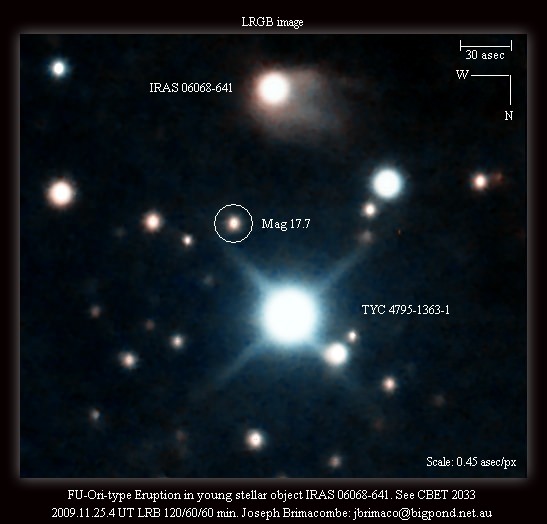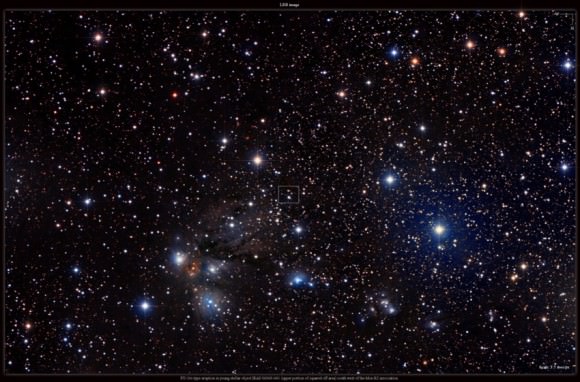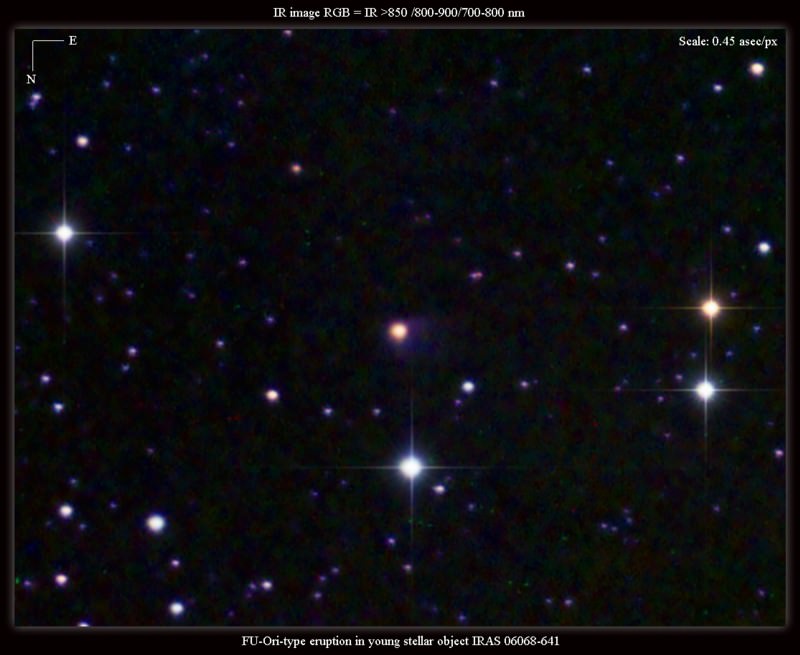What accretes quietly in the night and can be a blast to observe? Try a FUor… These high accretion, high luminosity phase pre-main sequence stars may only last a few decades – but display an extreme change in magnitude and spectral type in a very short period of time. While FU Orionis may be the prototype you know about, there’s a lot more to learn and even more to observe! Step outside in the dark with me and let’s take a look…
What we know so far about FU Orionis-type stars is they flare with abrupt mass transfer from an accretion disc onto a young, low mass T Tauri-type star. In itself, this is very exciting because nearly half of T Tauri stars have circumstellar disks or protoplanetary discs. These could very well be the forerunners of planetary systems similar to our own solar system! How do we know there is a disc there? Try variablility. “Variable circumstellar extinction is pointed out as responsible for the conspicuous variations observed in the stellar continuum flux and for concomitant changes in the emission features by contrast effect. Clumpy structures, incorporating large dust grains and orbiting the star within a few tenths of AU, obscure episodically the star and, eventually, part of the inner circumstellar zone, while the bulk of the hydrogen lines emitting zone and outer low-density wind region traced by the [OI] remain unaffected.” says E. Schisano (et al), “Coherently with this scenario, the detected radial velocity changes are also explainable in terms of clumpy materials transiting and partially obscuring the star.”
While accretion rates for a FUor could range anywhere from 4 to 10 solar masses annually and its eruptions last up to a year or longer, astronomers believe their entire lifetimes only last a few decades. The proto-star itself may also be limited to undergoing an average of one to two eruptions each year. “The brightness of FUors increases by several magnitudes within one to several years. The currently favored explanation for this brightness boost is that of dramatically rising accretion from the disc material around a young star. The mechanism leading to this accretion increase is a point of debate.” says S. Pfalzner, “The induced accretion rates, the overall temporal accretion profile, the decay time, and possibly the binarity rate we obtain for encounter-induced accretion agree very well with observations of FUors. However, the rise time of one year observed in some FUors is difficult to achieve in our simulations unless the matter is stored somewhere close to the star and then released after a certain mass limit is transgressed. The severest argument against the FUors phenomenon being caused by encounters is that most FUors are found in environments of low stellar density.”
Surprisingly enough, even given the short period of time in which a FUor exists, no one has ever seen one phase out. “A cross-correlation analysis shows that FUor and FUor-like spectra are not consistent with late-type dwarfs, giants, nor embedded protostars. The cross-correlations also show that the observed FUor-like HH energy sources have spectra that are substantively similar to those of FUors.” says Thomas P. Greene (et al), “Both object groups also have similar near-infrared colors. The large line widths and double-peaked nature of the spectra of the FUor-like stars are consistent with the established accretion disk model for FUors, also consistent with their near-infrared colors. It appears that young stars with FUor-like characteristics may be more common than projected from the relatively few known classical FUors.”
Just how common and observable are these unusual characters? A lot more than you might think. According to Bo Reipurth (et al); “The original FUor class was defined by a small number (5-6) of pre-main sequence stars that had been observed to brighten up by 3-6 magnitudes on time scales of 1-10 years. The class has since been augmented by a comparable number of stars that have similar spectra or SEDs to the classical FUors, but that have not been observed to behave photometrically in that way. It is likely that the FUor phenomenon is recurrent, but it is not at all clear whether it is a property shared by ordinary T Tauri stars, or whether it is confined to a special minority among them. It is important that more examples be found, and found promptly, and as the result of systematic search rather than by accident as has been the case in the past. The goal would be to examine, on a regular monthly basis, all the molecular clouds within about 2 kpc that lie along the galactic plane and Gould’ s Belt for faint (or previously invisible) stars that had brightened up by a magnitude or more. It is essential that any such detections be followed up spectroscopically as soon as possible, to weed out interlopers: flare stars, cataclysmic variables, Miras, and EXors (the latter also being pre-main sequence but which unlike FUors soon return to their original brightness level, usually in a year or less). All of these objects are readily distinguishable from one another even at modest spectroscopic resolution. Such an on-going survey would serve also to follow the development of FUors.”
So let’s do the FUor dance!

According to CBET 2033 released on November 21, 2009 from the International Astronomical Union: “The discovery of a possible FU-Ori-type eruption (see Hartmann and Kenyon 1996, ARAA 34, 207) is located at R.A. = 6h09m19s.32, Decl. = -6o41’55”.4 (equinox 2000.0), and coincident with the infrared source IRAS 06068-0641. Discovered by the CRTS on Nov. 10, it has been continuously brightening from at least early 2005 (when it was mag 14.8 on unfiltered CCD images) to the present magnitude of 12.6, and may possibly brighten further. On recent images, a faint cometary reflection nebula is visible to the east. A spectrum (range 350-900 nm), taken with the SMARTS 1.5-m telescope at Cerro Tololo, on November 17, shows H-alpha in emission, all other Balmer lines and He I (at 501.5 nm) in absorption, and a very strong Ca II infrared triplet in emission, confirming it to be a young stellar object. The object lies inside a dark nebula to the south of the Mon R2 association, and is likely related to it. In addition, also inside this dark nebula, a second object at R.A. = 6h09m13s.70, Decl. = -6o43’55”.6, coincident with IRAS 06068-0643, has been varying between mag 15 and 20 over the past few years, reminiscent of UX-Ori-type objects with very deep fades. Also, this second object supports a variable cometary reflection nebula, extending to the north. The spectrum of this object also shows H-alpha and the strong Ca II infrared triplet in emission.”
Visible? Yeah. You know it. And here are the wide field results as taken by Joe Brimacombe…

“A smaller site of ongoing star formation in the Mon R2 molecular cloud are the objects associated with GGD 16 and 17. To the south of GGD 17, the T Tauri star Bretz 4 is probably associated with the GGD object. This star has been studied spectroscopically and was classified by as a K4 spectral type with a class 5 emission spectrum.” says Carpenter and Hodapp, “The infrared source IRS 2 is positionally coincident with Bretz 4, while the more deeply embedded IRS 1 has no optical counterpart and lies between the GGD objects. A detailed optical study showed that GGD 17 is part of a curved jet extending north of the star Bretz 4 and consisting of HH 271, and possibly also HH 273. Nebulosity close to the star shows the typical morphology of scattered light from an outflow cavity wall. The embedded infrared objects and optical reflection nebulosity in the general GGD 16-17 region is associated with 850 um emission.”
Capture a FUor… It may be the most unusual thing you’ve ever done!
Many thanks to Joe Brimacombe for the awesome images and awakening my ‘FUor’ curiousity!


This was interesting to read, though I can’t think of any comments in particular. I am pondering whether these fluctuations of stars in a T-Tauri stage have some power spectrum based on the star’s mass.
LC